Landscape painting blossomed into the most popular genre in the nineteenth century, thanks largely to pioneers in the previous two centuries. One of those pioneers developed methods which were not fully realised until the twentieth century, and this year marks the three hundredth anniversary of his birth: he is Alexander Cozens (1717–1786).
We don’t know exactly when or where Cozens was born, but it was on a date in 1717, and somewhere in what was then the mighty Russian Empire. Although usually given as Saint Petersburg, it has also been proposed that he was born in Kasan, on the River Don (now Kazan, the capital city of the Republic of Tatarstan). His father was a British master shipbuilder who had been drawn from the shipyards at Deptford, England, to help create Peter the Great’s imperial navy.
Cozens was schooled in London from 1727, and apparently learned to etch by 1733, so presumably was by then in an apprenticeship in the city. His father died in 1735, and his family back in St Petersburg fell on hard times. Cozens returned to Russia, then in 1746 sailed to Italy, and in the Spring of that year settled in Rome.
He started working (and studying) in the studio of Claude-Joseph Vernet (1714-89), a French landscape painter who was enjoying considerable success at the time. Cozens was one of the first British artists to study and work in Rome: Richard Wilson (1714-82), considered another pioneer of landscape art, did not arrive until 1750.
Tragically, many of Cozens’ paintings from his time in Italy were lost in Germany during his return journey to England in 1749, and those which have survived were recovered from Florence by his son in 1776.
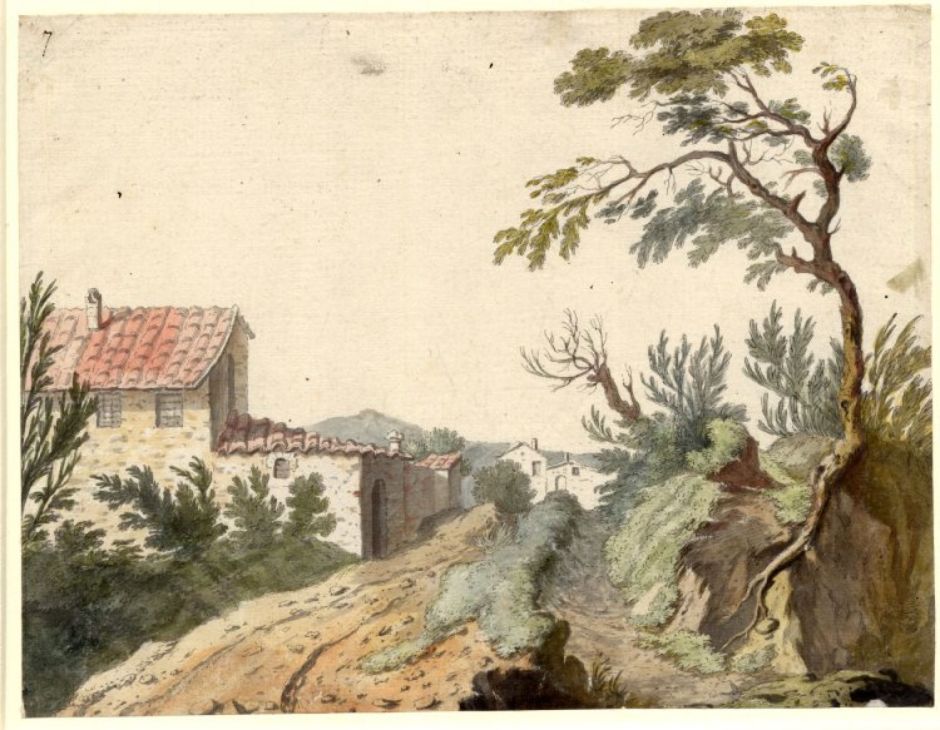
Among those recovered, this watercolour of An Italian Hamlet (c 1746) is in relatively good condition, and shows a fairly typical scene in rural Italy.
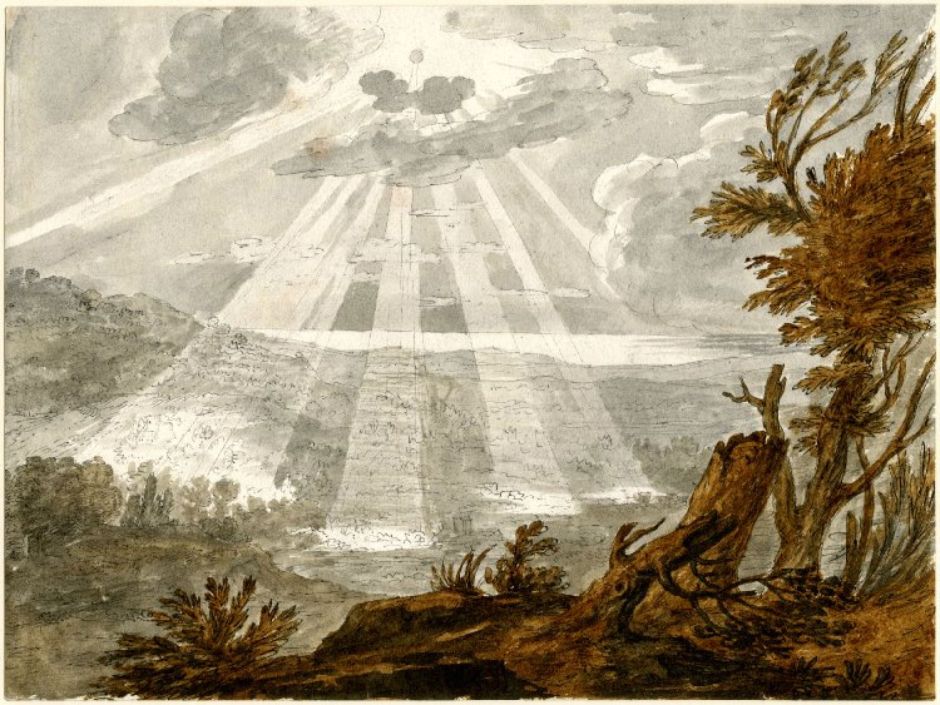
This untitled painting showing a landscape with the sun breaking from clouds (c 1746) show greater influence of Vernet, in its unusual treatment of light and more sophisticated composition.
In 1749, Cozens took up the appointment of drawing-master at the renowned Christ’s Hospital school in London, which had been founded by King Edward VI in 1552. He resigned from there to teach private pupils in 1754, and to work on methods for teaching drawing and the “inventing of landskips” – the composition of ‘ideal’ landscapes – which he started publishing in 1759.

The great majority of Cozens’ surviving work is in ink and watercolour, but nine of his oil paintings remain, including this view of the Vale Near Matlock (1756).

Four of his oil paintings are in the Mackworth Praed Book, including this beautiful Rocky Bay Scene (c 1759–65), painted in oils on paper. This demonstrates Cozens’ emphasis on form and light in composition. He also seems to have become knowledgeable about technical aspects of oil painting and to have used accelerators to promote rapid drying of his paint layers.
Cozens was elected a member of the Society of Arts in 1760 (the Royal Academy of Arts not being established until 1768), and exhibited two paintings at the first of its annual exhibitions that year. The following year, Cozens won a prize for his historical landscape The Retirement of Timolean, but that work, together with seventeen other oil paintings which he exhibited with the society over the following twenty years or so, have all vanished without trace.
Between about 1763-68, Cozens was the drawing-master at Eton College, where his pupils included the Prince of Wales, Sir George Beaumont, and William Beckford, who became the most important patrons and collectors of art of the period. Beaumont was an early supporter of John Constable, for example.
In 1765, Cozens published A Treatise on Perspective and Rules for Shading by Invention, although no copy now survives. That was followed by a series of other instructional manuals, including Principles of Beauty, Relative to the Human Head (1778), which combines aesthetics and physiognomy in the ‘characterisation’ of facial features.

Close of the Day: Sunset on the Coast (1768-75) is another of Cozens’ surviving oil paintings which lays emphasis on form and light.
When he was in Rome, Cozens apparently learned of Claude Lorrain’s methods, probably from Vernet. These inspired Cozens’ development of his ‘blot’ technique, which he described in his pamphlet of 1785, A New Method of Assisting the Invention in Drawing Original Compositions of Landscape. This technique had matured by 1757, and Cozens used it when teaching at Eton.

This undated A Blot-Lake with Boat, Surrounded by Trees is an example created using a brush and black ink, in which initial random blot shapes have been developed and expanded in a rough sketch.
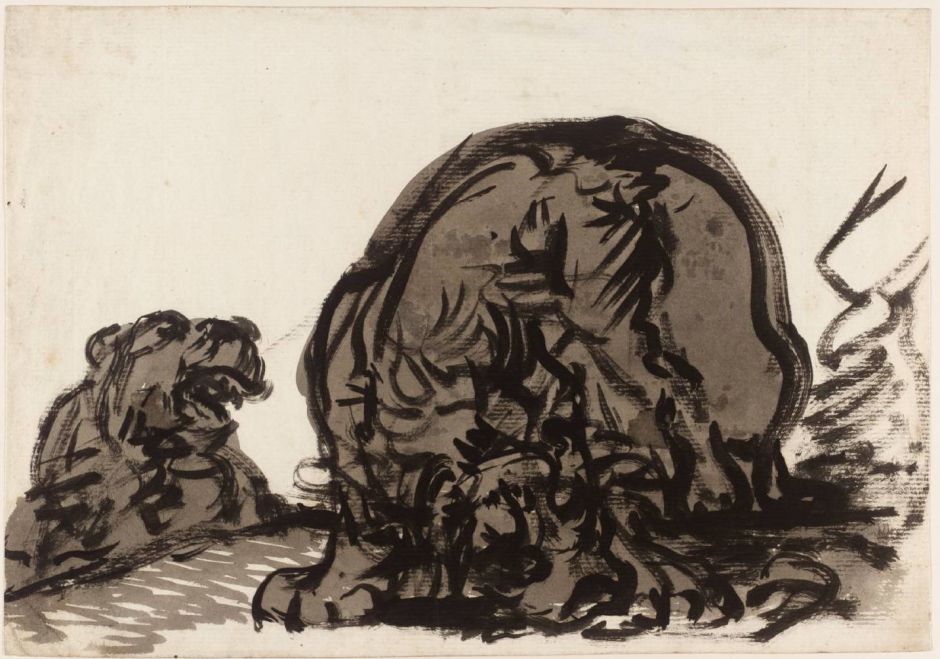
Sometimes Cozens’ blots didn’t just turn into landscapes, but into other motifs, such as his watercolour A Blot: Tigers (c 1770–80). After he had laid down initial grey wash ‘blots’ suggesting general form, Cozens transformed those by painting black marks over them, which brought to life the two tigers shown here.
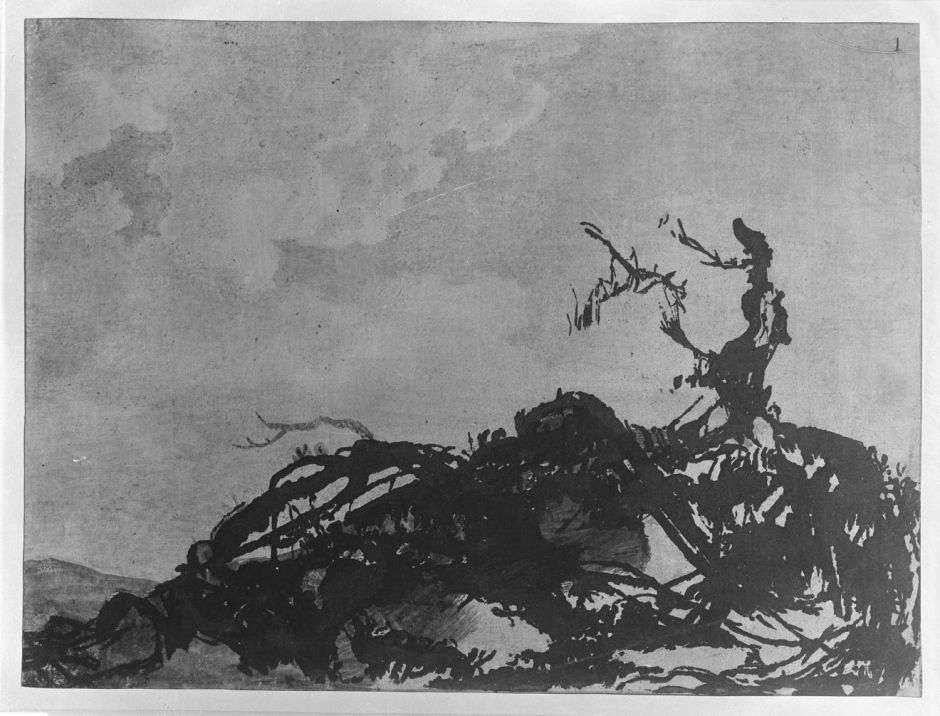
Cozens experimented with a range of radical techniques, some of which are shown in The Fallen Tree (c 1785), made by etching and aquatint. This builds up the form of a fallen tree from a collection of apparently random and very gestural marks – a technique which was not used much again for a century, and only really became established in the twentieth century.

Cozens argued that the simple arrangement of forms in landscape paintings could convey emotions and ideas. Mountainous Landscape (c 1780) is an imaginary landscape in which he tried to accomplish that, and to remain consistent with Burke’s concepts of ‘the sublime and beautiful’ from his writings of 1757. Cozens may have used blots at some early stage in creating this view, but more obvious are his carefully controlled washes and hatched strokes, which would probably have originated in his training in etching and engraving.
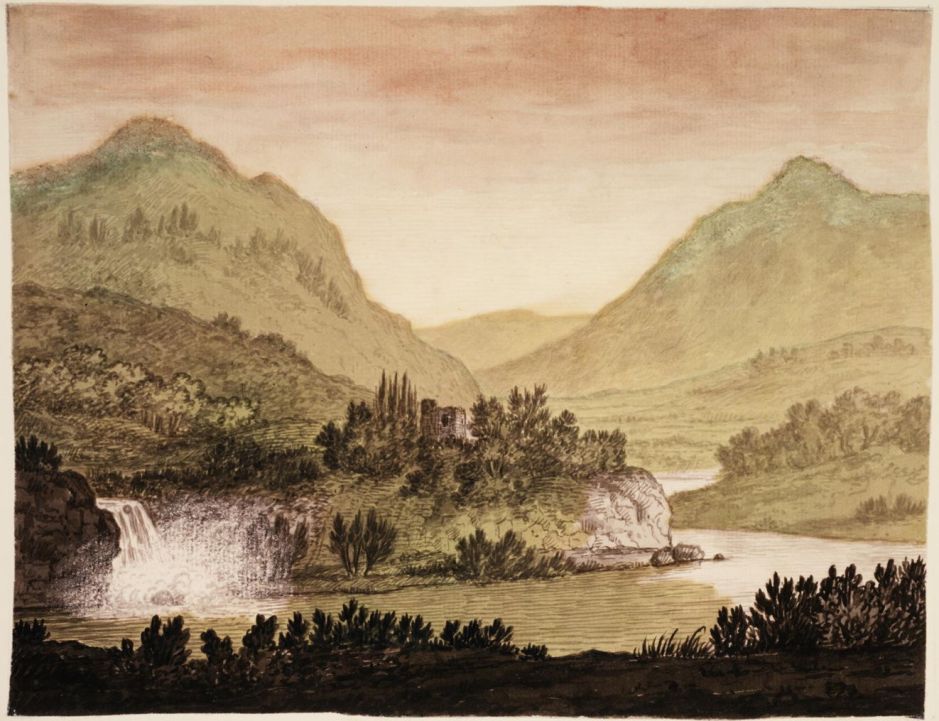
This undated ink and watercolour painting of a Mountainous Landscape with a Castle and Waterfall uses a range of techniques, including (most probably) scratching out to produce the effect of water mist around the waterfall. In other works, he was an early adopter of wet-in-wet watercolour painting.
Another method which was used and advocated by Cozens was the painting of skies, or skying, which became a favourite of Constable.
Disappointingly few of Cozens’ paintings have survived, barely enough to give an idea of his artistic accomplishment. However, his influence was great indeed: both Joseph Wright of Derby and John Constable were admirers of his work, and adopted some (at least) of his methods. Constable’s oil sketches in particular appear to be direct descendants of Cozens’ blot-based paintings. Cozens also attracted the attention and support of John Flaxman and Sir Joshua Reynolds.
Alexander Cozens’ son, John Robert (1752-97), went on to become a major landscape artist in his own right, and thankfully more of his work has survived than his father’s.
We may not be able to see many of Alexander Cozens’ paintings now, but we can appreciate his major contribution to the development of landscape painting in the work of John Constable, and even JMW Turner. I also wonder how many more modern painters have appreciated how some of their techniques were first taught to schoolboys at Eton by Alexander Cozens, in the middle of the eighteenth century.
References
Cozens, Alexander (1778) Principles of Beauty, Relative to the Human Head, available at archive.org
Sloan, Kim (1986) Alexander and John Robert Cozens, The Poetry of Landscape, Yale UP. ISBN 0 300 03826 7.

